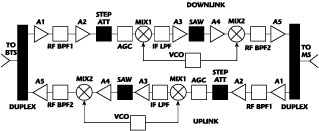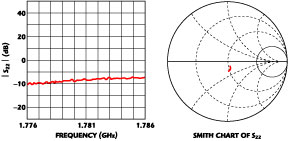Product Feature
Laser-activateable Plastics and Laser Devices that Deliver Flexible 3D MID Technology
LPKF Laser & Electronics
Garbsen, Germany
In an increasingly competitive market those companies carrying out electronic production, especially small- to medium-sized enterprises, require fast, efficient and cost-effective solutions to aid the prototyping and production process. What is called for is for long and expensive process chains to be eliminated and replaced with fewer, highly efficient and environmentally friendly steps.

Fig. 1 An REM photograph of a surface after laser structuring.
Ever increasing miniaturization and the great speed of modern laser processing methods has opened up the use of lasers for circuit structuring on injection-molded components. Additionally, a physio-chemical process controllable with electromagnetic radiation used to underpin short production steps has been turned into the laser direct structuring (LDS) process. Figure 1 illustrates a surface after laser structuring. The range of special laser-activateable plastics and laser devices precisely matched to process these plastics has been developed to deliver new, extremely flexible 3D molded interconnect device (MID) technology.

Fig. 2 The three steps required to manufacture an MID part: (1) injection molding; (2) laser structuring/activation and (3) electroless plating.
Laser structuring in MID production is generally taken to be a subtractive process comprising process chains, with a usual sequence of injection-molding, etching/nucleation, full-surface metallization, resist coating, resist laser structuring, etching and stripping.
Conversely, the additive LDS process only requires injection-molding, laser structuring and circuit metallization. Figure 2 shows these three stages. The key to this process simplification lies in the multi-functionalized MID plastics, through which the laser light creates metallization nuclei on the component surface at the same time as creating a surface structure which ensures excellent adhesion of the conductor lines created during subsequent metallization. The Institute for Interconnecting and Packaging Electronic Circuits (IPC) regulations require adhesion for electronic devices (especially PCBs) to be above 8 N/cm, and this is easily exceeded. The result of the process is that structures with approximately 100 mm resolution can easily be produced. After passing through the metallization bath (see Figure 3 ), where 3 to 5 mm of copper, 4 to 6 mm of nickel and 0.1 mm of gold are deposited, the modified plastic surface of the insulation zones lie cleanly adjacent to the metal surfaces of the circuit layout.

Fig. 3 A conventional metallization bath.
LDS Thermoplastics
The three types of thermoplastic granulate that have been developed are PPMID, which is polypropylene based, PBTMID, which is polybutylene-terephthalate based and PA6/ 6TMID, which is partial-aromatic polyamide based. Electroless, and following galvanic metallization with high adhesion strength, they are suitable for fine line circuits with line and space widths around 100 µm.
While PBTMID is popular for many applications, particularly because of the good electrical properties of the basic plastic PBT, the newly developed PA6/6TMID has high mechanical strength and rigidity, with a melting point at 295°C. This high temperature-resistance opens up a particularly large number of areas of application for the material. It delivers the basis for reflow soldering for the current lead-based soldering systems and also for future lead-free soldering systems up to 260°C. Figure 4 shows a product of this reflow process.

Fig. 4 A reflow soldered circuit carrier made of PA6/6 TMID.
3D MID Laser Systems
The fundamental property that makes laser technology so important for the production of complex highly integrated circuits for various sectors, including 3D MID, is the small focusing diameter of laser beams, which enables the production of conductor lines and separations of < 100 µm. The laser systems that have been specifically designed for the LDS process are modular. They have three 'optical axes' generated by a galvanometer scanner and a linear translator that enable the almost inertia-free and very rapid guidance of a focused laser beam. A 3D scanning head is shown in Figure 5 . The component processing is matched to the component complexity and, in addition to low cost solutions, there is also a precise positioning unit with five mechanical axes for the orthogonal alignment of the components' surfaces to the laser beam (in interior housing surfaces, for example).

Fig. 5 The 3D scanning head.
The modular nature of the laser systems allows the installation of different laser sources and also supports resist structuring with the capability of producing lines and spaces of approximately 50 µm, as shown in Figure 6 . Therefore, they can be used in the conventional, subtractive laser structuring process for MIDs. A big advantage is that apart from a 1k tool, which is always required when making thermoplastic and injection-molded parts, there are no initial costs.
The laser structuring speed achieved is between 250 to 2000 mm/s depending on the laser structuring technology used. This speed and flexibility makes the process particularly suitable for rapid prototyping. The CAD data controls the laser focus on the component and complex 3D surfaces can be constructed. All that is required to modify a design is to change the vectors for the laser structuring process (that is, no tool and no mask).

Fig. 6 RF connector in cooperation with Harting EO.
Advantages of MID Technology
The design freedom offered enables miniaturization and enhanced functionality to be achieved through the integration of electrical, mechanical, optical and magnetic functions in a thermoplastic. The part count is further reduced because the housing can be used as the circuit board itself. Presently, this is restricted to single or double layers, so the highly touted application of mobile phone circuitry is not yet practical. What is realistic for mobile phones is for antennas, connectors, the pad and distributed circuitry from the display to the circuit board.
As far as the user is concerned LPKF supplies the granulate which can be injection-molded and activated with the laser. Being of modular design the laser system is tailored to the client's needs. The basis is always a 3D scanning volume to move the laser focus along the surface and various laser sources are offered.
The same system can be used for mass production as for prototyping. Every part and application is different, so the adaptable component handling system can be tailored to the user's specific requirements. Users can produce a large scanning volume with a large spot size or a very small scanning volume with a very fine focus - the dimensions for x, y and z being customized and the focus spot diameter being dependent on the scanning volume. Also available are handling systems that can process larger parts, which are linear axis, swivel axis turntables in different configurations.
Applications
Specific applications of the process/system are the development of connectors for various applications, including the automotive industry, motor control systems, keyless entry, sensor systems such as in hearing aids and pressure sensors, consumer electronics and white goods. Another key application is in the telecomm market; for example, integration of the antenna into the mobile phone, where due to such a small spot size the antenna can be accurately tuned.
Conclusion
In the move towards miniaturization the ability to integrate electrical and mechanical functions (and therefore gain space) has been a key driver in the development of 3D MID technology. Alternatives to this method must support the costs of having a fixed tool. If changes need to be made additional costs are incurred, making the cost of prototyping prohibitive. However, the LPKF modular laser structuring system is not only capable of producing fine pitch below 100 µm in line width and line space, it is also highly flexible. Changing the layout simply means altering the data and the laser will follow the new path. This makes it suitable for both prototyping and high volume production, which is attractive to users as it is impractical to prototype on a different technology to the serial parts. Also, as the LDS process comprises just three stages - injection-molding, laser structuring and metallization - no etching and stripping chemicals are used and materials are recyclable, making it environmentally friendly. Applications are wide and varied for both existing and developing markets. Additional information may be obtained via e-mail at lpkf@lpkf.de or on the company's Web site at www.lpkf.de.
LPKF Laser & Electronics, Garbsen, Germany + 49 (0)5131 7095-0, Fax: + 49 (0)5131 7095-90 or Wilsonville, OR (503) 454-4200.
Circle No. 300
